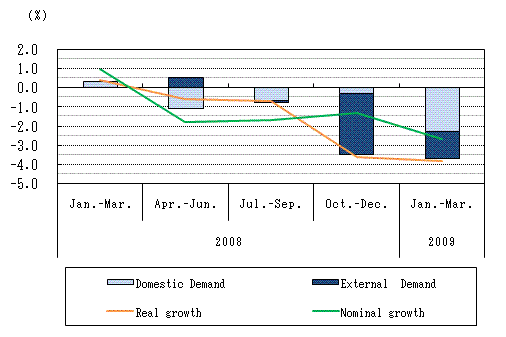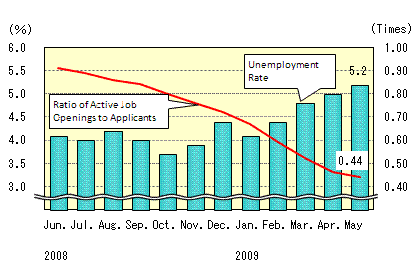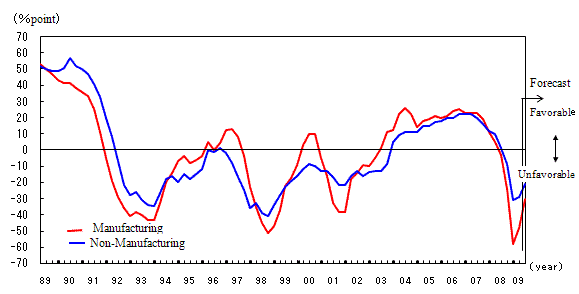Recent Statistical Survey Reports, June 2009
Statistical Survey Reports
Survey on Labor Economic Trend (May)
Monday, June 8, released by the Ministry of Health, Labour and Welfare
By the judgment of employment surplus or shortage DI as of May 1, 2009, regarding the trend of the sense of employment surplus or shortage, in the total of industries surveyed, regular employees and part-time workers accounted for -15. The DI shows the excess of surplus, unchanged from the previous survey.
Indexes of Business Conditions (Preliminary Report for April)
Tuesday, June 9, released by the Cabinet Office
The Coincident Index of Composite Index (CI, preliminary figures, 2005=100) in April was 85.8, an increase of 1.0 points, 3 months backward moving average decreased for 14 consecutive months, a decrease of 0.73 points, and 7 months backward moving average decreased for 14 consecutive months, a decrease of 1.80 points. So the Assessment of Coincident Index was "Worsening", but it also shows movements toward "Halting to fall". The Leading Index was 76.5, an increase of 1.0 points, and the Lagging Index was 86.1, a decrease of 1.4 points.
Basic Survey on Human Resource Development (FY2008)
Wednesday, June 10, released by Ministry of Health, Labour and Welfare
76.6% of the companies surveyed implemented off-the-job training for the regular-staffs, mostly unchanged from the previous fiscal year, while 59.4% of them provided on-the-job training, showing an increase of more than 10 points from the previous fiscal year. As for off-the-job training for the non-regular staffs, only 35.0% of them implemented it, which didn't reach half of that provided for regular-staffs. There was a big differential between the ratio of regular-staffs and that of non-regular staffs.
National Accounts (The 2nd Preliminary Estimates Jan.-Mar. 2009)
Thursday,
June 11, released by the Cabinet Office![]()
Real GDP (Gross Domestic Product) growth rate (Seasonally Adjusted) was -3.8% (-14.2% on annual basis), an increase of 0.2 points (1.0 points on annual basis) from the 1st Preliminary estimates.
Of real GDP growth rate, -2.3% was contributed by domestic demand and -1.4% by external demand.
Quartely Estimates of GDP: Jan. ~Mar. 2009 (The 2nd Preliminary Estimates) Growth rate of GDP from the previous Quarters(seasonally adjusted)
Contributions of Domestic Demand and External Demand to Changes in GDP

Consumer Price Index (May)
Friday, June 26, released by the Ministry of Internal Affairs and Communications
The Consumer Price Index was 100.6, a decrease of 1.1% from the same month the year before, decreased for 4 consecutive months. Omitting Fresh food, the comprehensive index was 100.5, a decrease of 1.1% from the same month the year before, decreased for 3 consecutive months.
And in the ward -areas of Tokyo in June, the former accounted for 100.1, a decrease of 1.5% from the same month the year before. The latter accounted for 100.0, a decrease of 1.3% from the same month the year before.
Indices of Industrial Production (May)
Monday, June 29, released by the Ministry of Economy, Trade and Industry
The index of industrial production (seasonally adjusted) increased by 5.9% from the previous month.
According to the Survey of Production Forecast in Manufacturing, Production is expected to increase in June and July. The Synthetic judgment is “Industrial Production shows signs of an upward movement.”
Survey on Corporate Successive Summer Holidays Plan (2009) (*)
Monday, June 29
The average number of total summer holidays provided by companies surveyed was 7.8days (8.1days in the previous year), while the average number of successive summer holidays was 5.6 days (5.8 days in the previous year).
(*)This fiscal year, National Federation of Labour Standards Associations conducted the survey, entrusted by the Ministry of Health, Labour and Welfare.
Family Income and Expenditure Survey (May)
Tuesday, June 30, released by the Ministry of Internal Affairs and Communications
The average monthly income for a worker's household with 2 or more family members was increased by 1.4% in real terms from the same month a year before.
With regard to the income contributing to increase - decrease rate, contribution of income earned by head of household accounted for -1.16 %, partner's income accounted for 0.90%, non-current income accounted for 2.39% (including 2.32% of the Supplementary Income Payments).
Labour Force Survey (May)
Tuesday, June 30, released by the Ministry of Internal Affairs and Communications
Report on Employment Service (May)
Tuesday, June 30, released by the Ministry of Health, Labour and Welfare
The unemployment rate (seasonally adjusted) was 5.2%, increased by 0.2 points from the previous month. That for men was 5.4%, increased by 0.1 points from the previous month, and that for women was 4.9%, increased by 0.3 points from the previous month.
The number of unemployed persons increased by 770 thousand from a year earlier to 3.47 million.
The number of employees (seasonally adjusted) decreased by 290 thousand from the previous month to 54.22 million.
The ratio of active job openings to applicants (seasonally adjusted) was 0.44, decreased by 0.02 points from the previous month.
Trend in Unemployment Rate and Ratio of Active Job
Openings to Applicants

Monthly Labour Survey (Preliminary Report in May)
Tuesday, June 30, released by the Ministry of Health, Labour and Welfare
Total amount of cash earnings (for business establishments with 5 or more employees) decreased by 2.9% from a year earlier, and contractual cash earnings decreased by 2.6% from a year earlier.
Scheduled cash earnings decreased by 1.4%, while non-scheduled cash earnings decreased by 17.6% from a year earlier. Real wage (total) decreased by 1.7% from a year earlier.
Non-scheduled hours worked by manufacturing industry workers at business establishments with 5 or more employees increased by 6.9% from the previous month (seasonally adjusted).
TANKAN (Short-Term Economic Survey of Enterprises) (June)
Wednesday,
July 1, released by the Bank of Japan(PDF:197KB)![]()
The Diffusion Index (DI) (“Favorable”- “Unfavorable”) for business conditions in large enterprises of the manufacturing was -48 (-58 in the previous quarter and forecast -30 in the coming quarter), and the non-manufacturing DI was -29 (-31 in the previous quarter and forecast -21 in the coming quarter), each Index also improved.
The Diffusion Index (DI) (“Excessive”- “Insufficient”) for employment conditions in large enterprises of all industries was 20 (20 in the previous quarter and forecast 14 in the coming quarter).
Business Sentiment(For Large Enterprise)

Other Reports
Monthly Economic Report (June)
Wednesday,
June 17, released by the Cabinet Office![]()
While the economy is in a difficult situation, movements of picking up are seen in some areas. (In the previous month, it was “the tempo of worsening has become moderate”.)
- Exports are showing movements of picking up. Industrial production is picking up. (In the previous month, “Exports and industrial production are nearing the bottom”.)
- Corporate profits are decreasing very substantially and business investment is decreasing substantially.(In the previous month, it was “decreasing”.)
- The employment situation, which is worsening rapidly, is severe. (The same as the previous month)
- Private consumption is weak, but some signs of nearing the bottom can be seen. (In the previous month, it was “decreasing moderately.”)
Monthly Economic Labour Report (June)
Thursday, June 18, released by the Ministry of Health, Labour and Welfare
In looking at the aspects of labor and economy, the employment situation, which is worsening rapidly, is severe. (The same as the previous month)
White Paper on the Labour Economy 2009
Tuesday, July 30, released by the Ministry of Health, Labour and Welfare
It is essential to make economic and industrial activities lively through people's job satisfaction based on employment stability. It is also important to develop an employment system under which fruits of good economic performance are appropriately distributed, and people can appreciate rich and stable working lives.
For securing employment stabilities and activizing economies;
Intensify addressing work sharing issues for employment stability of including for non-regular employees
Carry out various measures to promote re-entry into employment such as employment placement and vocational training through establishment of safety net.
For increasing income of various people by building their vocational capacities;
Promote employment stability and develop human resources under a long-term employment system
Address moving unsettled employees to regular ones and introducing a personnel system which can activate organization
For sophisticating industrial and employment structures and creating high-quality jobs;
View new industrial and employment structures and systematically develop human resources that bear them.
Carrying out comprehensive supports for the creation of new industrial and employment fields.
| To view PDF files, you will need Adobe Acrobat Reader Software installed on your computer.The Adobe Acrobat Reader can be downloaded from this banner. |

